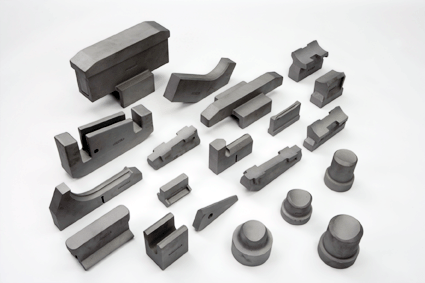Ductile iron castings have many advantages
Ductile iron castings are solid metal objects that result from molten ductile iron being poured into voids in a mold. The ductile iron subsequently cools and solidifies in the shape of the void it occupies.
What is Ductile Iron?
Invented in 1943, ductile iron is a modern iteration of cast iron. Cast iron and ductile iron have contrasting physical properties caused by differences in their microstructures.
The graphite and carbon contained in cast iron occur as flakes; cast iron exhibits positive compressive load capabilities, but tensile loading above its natural tensile strength can cause cracks to form and propagate rapidly out from stress points within the flaked graphite microstructure. As a result, cast iron has virtually no elongation. It is a brittle material, and therefore limited in its use in tensile and shock loading applications.
The graphite within ductile iron occurs as spheroids, so it is sometimes referred to as spheroidal graphite. Similarly, the term nodular iron stems from the fact that the carbon contained in ductile iron is held in the form of nodules. This unique microstructure causes ductile iron to withstand bending and shock loading far better than traditional cast iron.
What is Ductile Iron made from?

While ductile iron can be produced from steel or iron scrap, pig iron is the primary source of infeed for most modern ductile iron foundries. Pig iron refers to the primary iron production of a blast furnace that contains over ninety percent iron.
The term“pig iron”arose from the old-fashioned method of casting blast furnace iron into molds arranged in sand beds in such a manner that they could be fed from a common runner. Because the groups of molds resembled a litter of suckling pigs, the individual pieces of iron were referred to as“pigs”and the runner was referred to as a sow. Modern pigs are produced by a continuous pig casting machines.
Pig iron is used in ductile iron production as a primary source of pure iron. It offers a number of unique advantages: pig iron contains low residual or harmful elements, has a consistent chemistry, promotes optimal slag conditions, and improves process control by providing consistent charge properties. Demand for pig iron has increased in recent years as ductile iron foundries utilize its advantages over alternate iron sources such as iron scrap, or melting steel scrap and adding carbon.
Advantages of Ductile Iron
There are several advantages that ductile iron provides designers:
- Ductile iron can be easily cast and machined.
- It has an excellent strength to weight ratio.
- Ductile iron can be made for a much lower cost than steel.
- It has superior cast ability and machine ability.
- Ductile iron provides a designer with an exceptional combination of toughness, low cost manufacturing, and reliability.
Properties of Ductile Iron
To create different grades of ductile iron, one must control the matrix structure around the graphite during the casting process or through subsequent heat treatment. The minor compositional differences between the different grades of ductile iron exist in order to create the desired matrix (micro structures).
Ductile iron can be considered as steel with graphite spheroids dispersed throughout its matrix. The qualities of the metallic matrix in which the graphite spheroids are suspended have a significant effect on ductile iron’s properties, but the graphite spheroids themselves do not.
There are several matrices found within ductile iron, the most common being;

- Ferrite – a pure, ductile, flexible iron with little strength. This matrix has poor wear resistance, but high impact resistance and good machine ability.
- Pearlite – a mechanical mixture of ferrite and iron carbide (Fe3C). It is relatively hard, with moderate ductility. It has high strength, good wear resistance, moderate impact resistance, and good machine ability.
- Pearlite/Ferrite – a structure consisting of a mixture pearlite and ferrite, and the most common matrix for commercial grades of ductile iron.
Common Ductile Iron Grades
While there are many different ductile iron specifications, foundries routinely offer 3 common grades;
Ductile Iron Applications
Ductile iron has greater strength and ductility than gray iron. Those properties allow it to be used effectively in a wide variety of industrial applications, including pipe, automotive components, wheels, gear boxes, pump housings, machine frames for the wind-power industry, and many more. Because it does not fracture like gray iron, ductile iron is also safe to use in impact-protection applications, such as bollards.


 O.B.T Manufacture
O.B.T Manufacture 

